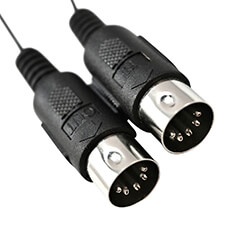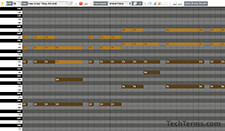MIDI
Stands for "Musical Instrument Digital Interface." MIDI is a connectivity standard for transferring digital instrument data. It is primarily used by computers, synthesizers, and electronic keyboards. However, MIDI is supported by several other instruments, such as electronic drums, beat boxes, and even digital stringed instruments like guitars and violins.
MIDI data includes several types of information. For example, pressing a single key on a synthesizer transmits the note played, the velocity (how hard the note is pressed), and how long the note is held. If multiple notes are played at once, the MIDI data is transmitted for all the notes simultaneously. Other data that may be sent over a MIDI connection includes the instrument ID, sustain pedal timings, and controller information, such as pitch bend and vibrato.
When a synthesizer is hooked up to a computer via a MIDI connection, the notes played can be recorded by DAW software in MIDI format. The MIDI data can be played back by sending the recorded MIDI notes to the keyboard, which outputs them as audio samples, such as a piano or strings. Most DAW software supports MIDI editing, allowing you to adjust the timing and velocity of individual notes, change their pitch, delete notes, or add new ones. MIDI data is often displayed in a digital format, with lines representing each note played. Many programs can convert MIDI data to a musical score as well.
Originally, MIDI connections used MIDI cables, which connected to a 5-pin MIDI port on each device. Now, most MIDI devices have standard computer interfaces, such as USB or Thunderbolt ports. These modern interfaces provide more bandwidth than traditional MIDI ports, allowing more tracks with more data to be transmitted at once.
General MIDI
The MIDI standard defines 128 "General MIDI" (or GM) instruments, which are available on most computers as software instruments. The sound of each General MIDI instrument may vary between different computers and keyboards because the samples used for the instruments may be different. However, the ID for a GM instrument is the same across devices. For example, GM instrument #1 is always an acoustic piano, #20 is a church organ, and #61 is a french horn. Modern synthesizers typically include hundreds or even thousands of other instruments that can be selected, most of which provide more authentic sound than the General MIDI options.
 Test Your Knowledge
Test Your Knowledge
